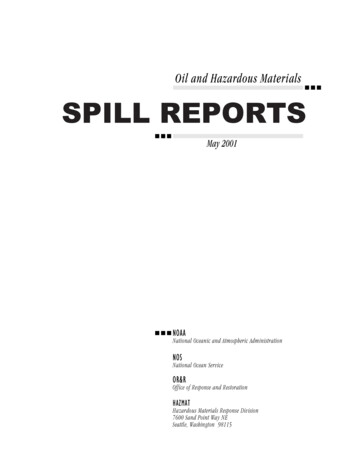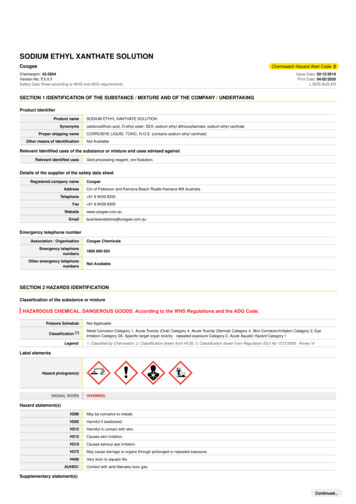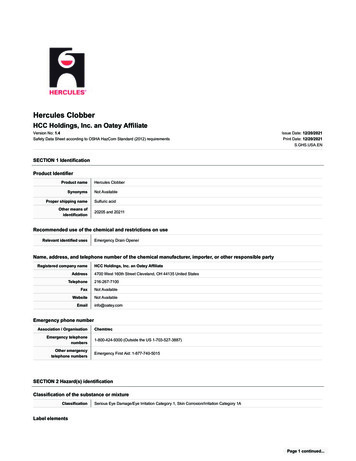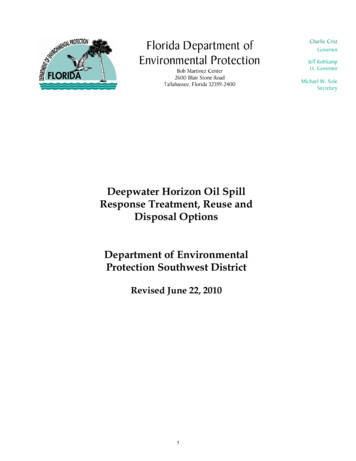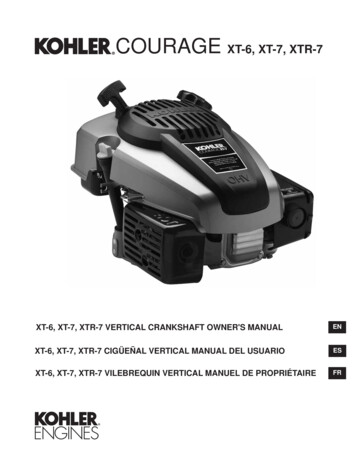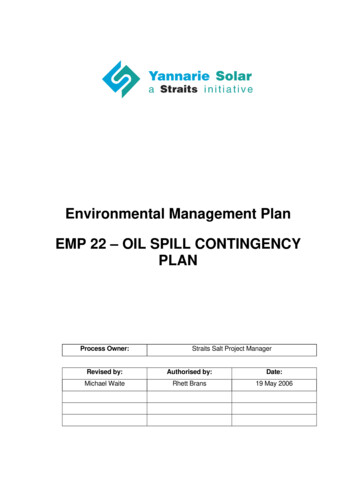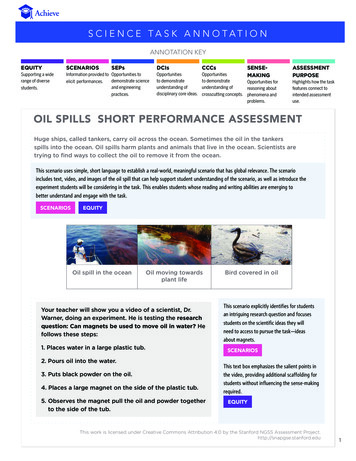
Transcription
S C I E N C E TA S K A N N O TAT I O NANNOTATION KEYEQUITYSCENARIOSSupporting a widerange of diversestudents.Information provided to Opportunities todemonstrate scienceelicit performances.and engineeringpractices.SEPsDCIsCCCsOpportunitiesto demonstrateunderstanding ofdisciplinary core ideas.Opportunitiesto demonstrateunderstanding ofcrosscutting concepts.SENSEMAKINGASSESSMENTPURPOSEOpportunities forreasoning aboutphenomena andproblems.Highlights how the taskfeatures connect tointended assessmentuse.OIL SPILLS SHORT PERFORMANCE ASSESSMENTHuge ships, called tankers, carry oil across the ocean. Sometimes the oil in the tankersspills into the ocean. Oil spills harm plants and animals that live in the ocean. Scientists aretrying to find ways to collect the oil to remove it from the ocean.This scenario uses simple, short language to establish a real-world, meaningful scenario that has global relevance. The scenarioincludes text, video, and images of the oil spill that can help support student understanding of the scenario, as well as introduce theexperiment students will be considering in the task. This enables students whose reading and writing abilities are emerging tobetter understand and engage with the task.SCENARIOSEQUITYOil spill in the oceanOil moving towardsplant lifeYour teacher will show you a video of a scientist, Dr.Warner, doing an experiment. He is testing the researchquestion: Can magnets be used to move oil in water? Hefollows these steps:1. Places water in a large plastic tub.2. Pours oil into the water.3. Puts black powder on the oil.4. Places a large magnet on the side of the plastic tub.5. O bserves the magnet pull the oil and powder togetherto the side of the tub.Bird covered in oilThis scenario explicitly identifies for studentsan intriguing research question and focusesstudents on the scientific ideas they willneed to access to pursue the task—ideasabout magnets.SCENARIOSThis text box emphasizes the salient points inthe video, providing additional scaffolding forstudents without influencing the sense-makingrequired.EQUITYThis work is licensed under Creative Commons Attribution 4.0 by the Stanford NGSS Assessment Project.http://snapgse.stanford.edu1
OIL SPILLS SHORT PERFORMANCE ASSESSMENT (CONTINUED)1. D r. Warner put a black powder on the oil duringhis experiment. What do you think wouldhappen if he did his experiment without thepowder? Explain why.This question provides students with a scaffold to begin criticallythinking about the experiment and to help focus student attention onthe relevant aspects of the experiment. While it doesn’t explicitlyassess a targeted SEP, DCI, or CCC, it does provide important onramping and prompts to help students begin sense-making about theexperiment.EQUITYExplain Why:Dr. Warner used a magnet to pull powder (andoil) to the side of the tub. One student asks,“How can a magnet pull something withouttouching it?”SENSE-MAKINGThe text and image included here help break the driving scenariointo digestible chunks by focusing student attention and thinking onthe most relevant aspect of the scenario. This can help scaffoldstudents toward demonstrating the targeted student performance.EQUITYDr. Warner holds the magnet and some ofthe oil and powder move toward the magnet.This work is licensed under Creative Commons Attribution 4.0 by the Stanford NGSS Assessment Project.http://snapgse.stanford.edu2
OIL SPILLS SHORT PERFORMANCE ASSESSMENT (CONTINUED)2. Explain how the magnet caused the powder tomove without touching itSuccessfully responding to this question requires that students develop awritten description that demonstrates the understanding that magnets cancause objects to move without being in contact with each other if the objectsare magnetic. This most closely connects with part of the 3rd grade DCIelement PS2.B “ magnetic forces between a pair of objects do not requirethat the objects be in contact the [size] of the force depends onproperties of the objects ”. This question requires application of part of theDCI, but can largely be answered by stating the DCI, rather than requiring itsapplication.It should be noted that the scoring rubric suggests that this question assessesmore of the DCI, part of the SEP #1 Asking Questions, and the CCC Causeand Effect. These are not assessed here because: Students do not need to bring an understanding of how distanceinfluences the size of the forces to bear to respond to this task [note:this could easily be modified to target the DCI more comprehensively]; Students are not themselves asking questions; and While a correct student response is an example of a cause and effectrelationship, students do not need to bring their understanding ofcause and effect relationships to the table to respond to the question,since the DCI is sufficient.DCIsSEPsCCCsCONNECTION TO ASSESSMENT PURPOSEThis work is licensed under Creative Commons Attribution 4.0 by the Stanford NGSS Assessment Project.http://snapgse.stanford.edu3
OIL SPILLS SHORT PERFORMANCE ASSESSMENT (CONTINUED)Dr. Warner’s experiment answered his research question. He was able to use a magnet to move some of theoil in the water. But he is not sure if he can use magnets to remove all of the oil from the water.Dr. Warner putting black powder on the oil3. W hat other research questions could he test tosee if he can remove all of the oil in the water?Write one research question and explain how itwill help him decide if he can remove all of theoil.Because the questions are constrained to removing all the oil withmagnets, students must 1) use an understanding of the properties ofmagnets (e.g, that magnetic forces between objects depend onproperties of those objects and distance) to make sense of thescenario and what would provide relevant information, 2) understandwhat makes a good and relevant research question, and 3) be able toarticulate their reasoning. This question requires students to sensemake with an SEP and DCI.This most closely connects with: part of the 3-5 SEP asking questions and defining problemselement “ask questions that can be investigated ” part of the 3rd grade DCI element PS2.B “ the sizes of theforces in each situation depend on the properties of the objectsand their distance apart ”It should be noted that this question could elicit studentunderstanding of CCCs. While open-ended and difficult to targetspecifically, student questions could very meaningfully reveal CCCunderstanding in both the questions they pose and the rationale forhow that question will help Dr. Warner.SENSE-MAKINGDCIsSEPsCCCsThis work is licensed under Creative Commons Attribution 4.0 by the Stanford NGSS Assessment Project.http://snapgse.stanford.edu4
OIL SPILLS SHORT PERFORMANCE ASSESSMENT (CONTINUED)Dr. Warner has already tested his research question by doing an experiment in his lab. Now he needs todesign a new experiment that he can test on an oil spill in the ocean.Oil Spill in the Ocean — brown color depicts the oilHe knows that the black powder can be used to remove oil from a tub of water in his lab.4. D escribe one way his experiment will need tochange to test his research question on a realoil spill. Then explain how that change will helphim decide if magnets can be used to removeoil from the oceanExplain:This part of the prompt requires students to sense-make by 1)evaluating the experimental design as well as the two situationsprovided, and 2) think about what is different between a real oil spilland what we see in the lab (e.g., size of the spill). Successfullyanswering this question would likely elicit student understanding ofhow magnets work (parts of 3-PS2.B identified above) to evaluateand modify the experimental design.While the scoring rubric suggests that this is requires students to usethe Defining Problems SEP element “define a simple problem ”,students are not defining a problem because they are not describing asituation people want to change or identifying criteria and constraintsfor solutions to that problem—instead, they are evaluating a design(the current experimental approach). This more closely connects tothe 3-5 SEP Planning and Carrying Out Investigations element“evaluate appropriate methods and/or tools for collecting data.”SEPsDCIsSENSE-MAKINGCONNECTION TO ASSESSMENT PURPOSEThis work is licensed under Creative Commons Attribution 4.0 by the Stanford NGSS Assessment Project.http://snapgse.stanford.edu5
Oil Spill in the Ocean — brown color depicts the oil 4. Describe one way his experiment will need to change to test his research question on a real oil spill. Then explain how that change will help him decide if magnets can be used to remove oil from the ocean Explain: He knows that the black powder can be used to remove oil from a tub of .
